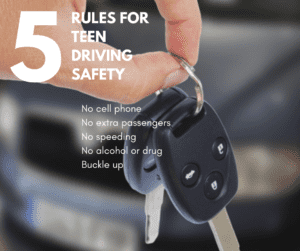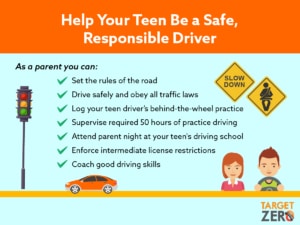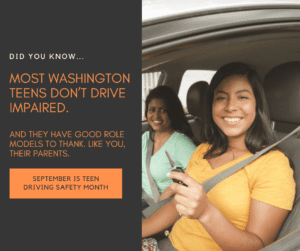Teen Driving Safety Overview
The focus throughout the month of September is teen driving and providing you with resources to help parents with constructive and active steps they can take to help their teen establish a lifetime of safe and responsible driving.
It’s no secret that parental or adult involvement can make a difference in helping teen drivers understand and follow good driving behavior patterns. Your organization can play an important role in helping to educate parents and teens in your community about some simple but effective rules of the road.
Reinforce the message that parents can and should Be a Road Model. Here are some suggested content that can be adopted in a variety of ways: posting on social media, email messages to your members or constituents, or on your organization’s website.
The 5 Rules for Parents of Teen Drivers
Parents should insist their driving teens adhere to 5 rules while driving:
-
No cell phone
-
No extra passengers
-
No speeding
-
No alcohol or drugs
-
Buckle up
Parents Can Coach Their Teen Driver
Feel free to suggest using the following resources to be an active participant and coach to teach their teen(s) how to be a safe driver:
Visit the Washington Department of Licensing Parent’s Guide to Teen Driving. This comprehensive guide is a great resource for parents with teen drivers. The guide covers:
-
Knowing and enforcing the driving laws
-
Knowing the Intermediate driver license requirements and holding teens accountable to the rules
-
Certifying that your teen has completed at least 50 hours of supervised driving, including 10 hours at night
-
Setting family driving rules and limits
-
Talking to other parents to make sure they are enforcing the same rules with their teens
Other Resources for Parents and Teens
Download apps:
-
Road Ready: a free mobile app that provides a digital way to log required learner’s practice miles, with a social component to allowing teens to share their accomplishments with peers.
-
Life360: another free mobile app that can track and share the driving behaviors of everyone in the family. More than just a way to monitor teens, it encourages conversation among all family members about how each is driving, helping create a culture of driving safety within your family.
With interactive tools and resources, including widgets and a webinar for parents, AAA provides parents with great resources and advice to help them become effective in-car coaches, with advice on managing their teen’s overall driving privileges.
Young Driver Parenting: A non-profit organization offers training, tips and resources for parents, including sample safe driving agreements that parents and each young driver in the family can sign and follow.
Sample Email & Website Messages
The following are suggested messages that you can tailor to emails messages or post on your website or email to your constituency.
MESSAGE 1:
Teen Driving Safety is the focus for the month of September. For parents with teenage drivers, here are some quick facts to know before their teen gets behind the wheel.
Did you know:
-
Most Washington teens don’t drive impaired.
-
Know the risk: 57% of fatal crashes involving a young driver include impairment as a factor.
-
93% of 12th grade students in Washington don’t drive after consuming alcohol.
-
84% of 12th grade students in Washington don’t drive after using cannabis.
(Source: Washington Healthy Youth Survey 2018. More young driver information at: https://wtsc.wa.gov/programs-priorities/young-drivers/)
MESSAGE 2:
If you really want to customize information about the importance of teen driving safety in your region or community, here’s a way to do that:
Localized version – Include data from your region* (example):
-
91% of 12th grade students in Whatcom County don’t drive after consuming alcohol.
-
83% of 12th grade students in Whatcom County don’t drive after using cannabis.
*Find Healthy Youth Survey data for your region at: https://www.askhys.net/FactSheets
-
Under “Select Survey Year” choose 2018
-
Under “Select Location” choose your county
-
In the section titled “Safety and Violence Behaviors” check “12th ” in the row titled “Unintentional Injury”
-
Click “Get Report”
Here are sample messages and graphics that you can incorporate into your social media posts. Please click on the link below each image to download for posting on Facebook and Twitter.
More than 100 young people die on Washington roads each year, and it’s completely preventable. As parents, you can be a good role model for teaching your teen safe driving behavior.
https://wadrivetozero.com/young-drivers/
Teen drivers look to you as parents to help them be safe when they get behind the wheel. Be a role model and a coach for your child. https://wadrivetozero.com/young-drivers/

Motor vehicle crashes are the leading cause of unintentional death for young people ages 16-25 in Washington. https://wtsc.wa.gov/programs-priorities/young-drivers/

Video Links
Using short videos is a popular way to reinforce messages important to instilling safe driving practices and behavior for our teen drivers. Feel free to embed in your social media posts, email messages, or on your website.
Not wearing a seat belt? Now that’s just scary. Buckle Up
Setting an example: I feel safer when I’m buckled up and when she’s buckled up.
“I know the importance of wearing a seat belt.” Tina, a health care worker and a mom, speaks out.
Quick Facts
Teen Driving Safety:
-
Most Washington teens don’t drive impaired.
-
Know the risk: 57% of fatal crashes involving a young driver include impairment as a factor.
-
93% of 12th grade students in Washington don’t drive after consuming alcohol.
-
84% of 12th grade students in Washington don’t drive after using cannabis.
(Source: Washington Healthy Youth Survey 2018 More young driver information at: https://wtsc.wa.gov/programs-priorities/young-drivers/)



